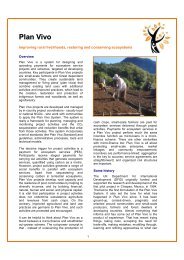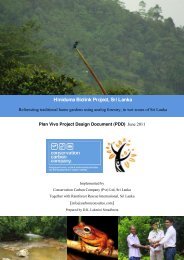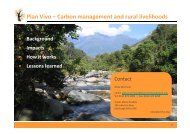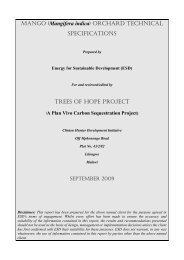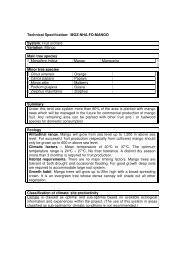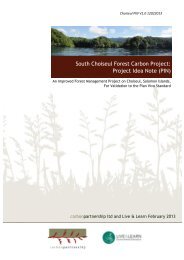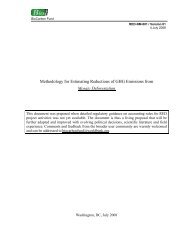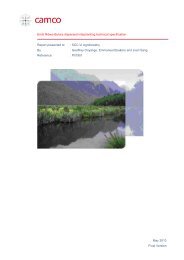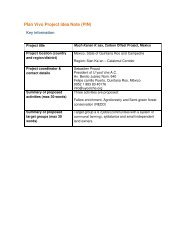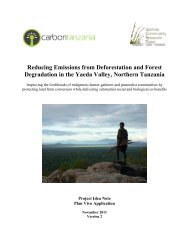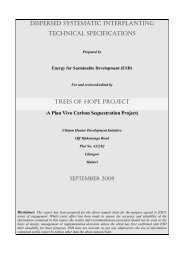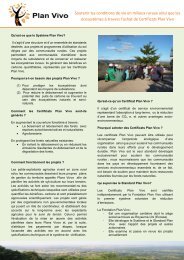First leaflet on the flagship project in Mozambique - Envirotrade
First leaflet on the flagship project in Mozambique - Envirotrade
First leaflet on the flagship project in Mozambique - Envirotrade
Create successful ePaper yourself
Turn your PDF publications into a flip-book with our unique Google optimized e-Paper software.
The <strong>project</strong> <strong>in</strong>volves reforest<strong>in</strong>g degraded forest and<br />
alter<strong>in</strong>g land use patterns <strong>in</strong> mashambas (areas of land<br />
"slashed and burned " for crop plant<strong>in</strong>g and left <strong>in</strong> fallow<br />
due to soil degradati<strong>on</strong>) with <strong>in</strong>digenous Miombo<br />
woodland trees, primarily local fruit and bee-fodder<br />
species, fruit trees and o<strong>the</strong>r selected species al<strong>on</strong>g<br />
watersheds to help stabilise <strong>the</strong> riverbanks.<br />
The <strong>project</strong> is work<strong>in</strong>g with local people who c<strong>on</strong>tract<br />
with <strong>the</strong> <strong>project</strong> to plant and ma<strong>in</strong>ta<strong>in</strong> trees am<strong>on</strong>gst<br />
<strong>the</strong>ir crops and around <strong>the</strong>ir homesteads. Participants <strong>in</strong><br />
<strong>the</strong> <strong>project</strong> are paid USD 7 per t<strong>on</strong>ne of carb<strong>on</strong> stored by<br />
<strong>the</strong> trees <strong>the</strong>y plant. Already <strong>the</strong> <strong>project</strong> has received an<br />
order for 2500 t<strong>on</strong>nes of carb<strong>on</strong> sequestrati<strong>on</strong> from<br />
Future Forests (a UK company) and <strong>project</strong> <strong>in</strong>vestment<br />
from private <strong>in</strong>vestors. Fur<strong>the</strong>r sales are expected to<br />
follow.<br />
c<strong>on</strong>sists of plant<strong>in</strong>g of <strong>in</strong>digenous and fruit trees <strong>on</strong><br />
forest land cleared for agricultural purposes to<br />
dem<strong>on</strong>strate that trees and agriculture can co-exist. Sixty<br />
two mashamba (slash and burn plots) owners have<br />
signed up for this phase of <strong>the</strong> <strong>project</strong>. Their mashambas<br />
have been mapped and a detailed profile developed of<br />
data relat<strong>in</strong>g to land use and o<strong>the</strong>r physical <strong>in</strong>formati<strong>on</strong>.<br />
Mashamaba owners have participated <strong>in</strong> this process<br />
that <strong>in</strong>cludes c<strong>on</strong>sultati<strong>on</strong> and plant<strong>in</strong>g of some 10 000<br />
trees of appropriate and desired species.<br />
The sec<strong>on</strong>d, much larger phase of <strong>the</strong> <strong>project</strong>, <strong>in</strong>volves<br />
<strong>the</strong> systematic rehabilitati<strong>on</strong> of a 100 000 hectare area of<br />
community land border<strong>in</strong>g <strong>the</strong> Nati<strong>on</strong>al Park. This<br />
<strong>project</strong> is a partnership between <strong>the</strong> Nhambitha<br />
Community, <strong>the</strong> University of Ed<strong>in</strong>burgh, <strong>the</strong> European<br />
Uni<strong>on</strong> and ICRAF, ECCM and <strong>Envirotrade</strong> Ltd as <strong>the</strong><br />
implement<strong>in</strong>g agencies. This phase of <strong>the</strong> <strong>project</strong> will<br />
focus <strong>on</strong> forest habitat restorati<strong>on</strong> and deforested areas<br />
will be targeted for systematic replant<strong>in</strong>g. The European<br />
Commissi<strong>on</strong> has committed 1.6 milli<strong>on</strong> euros to <strong>the</strong><br />
<strong>project</strong> over a five year period to kick-start <strong>the</strong><br />
producti<strong>on</strong> of carb<strong>on</strong>-offsets for sale.<br />
<strong>Envirotrade</strong> will work closely with <strong>the</strong> Community<br />
Associati<strong>on</strong> to build representative and accountable<br />
structures <strong>in</strong> l<strong>in</strong>e with <strong>the</strong> Plan Vivo model and to<br />
commercialise <strong>the</strong> susta<strong>in</strong>able exploitati<strong>on</strong> of n<strong>on</strong>-timber<br />
forest products. Carb<strong>on</strong> sequestrati<strong>on</strong> will be achieved<br />
us<strong>in</strong>g <strong>the</strong> follow<strong>in</strong>g techniques,<br />
Target<strong>in</strong>g deforested areas with<strong>in</strong> <strong>the</strong> next five years<br />
with a programme of habitat-restorati<strong>on</strong> re-establish<strong>in</strong>g<br />
Miombo woodland, enhanc<strong>in</strong>g biodiversity and work<strong>in</strong>g<br />
with <strong>the</strong> Nati<strong>on</strong>al Park adm<strong>in</strong>istrati<strong>on</strong> to restore <strong>the</strong> park<br />
to its former status as <strong>Mozambique</strong>’s premier wild life<br />
park are key <strong>project</strong> objectives.<br />
<strong>Mozambique</strong> has suffered enormously as a result of<br />
global climate change and envir<strong>on</strong>mental degradati<strong>on</strong><br />
with devastat<strong>in</strong>g floods exacerbated by <strong>the</strong> destructi<strong>on</strong><br />
of forest <strong>in</strong> <strong>the</strong> watershed areas of its major rivers. This<br />
<strong>project</strong> sets out to dem<strong>on</strong>strate that it is possible to<br />
address <strong>the</strong>se issues <strong>in</strong> a susta<strong>in</strong>able manner.<br />
The carb<strong>on</strong> offset generated by tree plant<strong>in</strong>g is sold <strong>on</strong><br />
<strong>the</strong> <strong>in</strong>ternati<strong>on</strong>al carb<strong>on</strong> trad<strong>in</strong>g market or to <strong>in</strong>dividual<br />
companies eager to neutralise <strong>the</strong>ir carb<strong>on</strong> emissi<strong>on</strong>s and<br />
comply with <strong>the</strong> requirements of <strong>the</strong> Kyoto protocol.<br />
The Plan Vivo system aims to achieve a strategic<br />
positi<strong>on</strong> <strong>in</strong> <strong>the</strong> future develop<strong>in</strong>g carb<strong>on</strong> emissi<strong>on</strong><br />
market that is estimated to grow to £20 billi<strong>on</strong> by 2025.<br />
The first phase of <strong>the</strong> <strong>project</strong> <strong>in</strong>volves a community<br />
“learn<strong>in</strong>g through do<strong>in</strong>g” pilot exercise to raise<br />
awareness about carb<strong>on</strong> management and <strong>the</strong><br />
c<strong>on</strong>servati<strong>on</strong> of trees. This phase, which is underway,<br />
• Agroforestry, to improve <strong>the</strong> fertility of <strong>the</strong> soil and<br />
provide a range of products for domestic use such as<br />
fuel wood and fodder for livestock. Improv<strong>in</strong>g<br />
agricultural systems reduces <strong>the</strong> pressure for<br />
farmers to clear new areas of forest for crops.<br />
• Live fences, (<strong>in</strong>digenous Miombo biome forest<br />
species) to provide shelter and shade al<strong>on</strong>g<br />
mashamba boundaries<br />
• Plant<strong>in</strong>g of <strong>in</strong>digenous species fruit trees adjacent to<br />
dwell<strong>in</strong>gs to provide a fruit crop and shade.<br />
• Riparian stabilizati<strong>on</strong> plant<strong>in</strong>g.<br />
• Habitat restorati<strong>on</strong> <strong>in</strong> severely degraded areas.<br />
Mashambas will be planted with bee fodder, nitrogen<br />
fix<strong>in</strong>g and fruit trees to provide l<strong>on</strong>g-term carb<strong>on</strong><br />
storage. Estimated carb<strong>on</strong> storage is based <strong>on</strong> basic<br />
mensurati<strong>on</strong> data from forest plots. Growth rates were<br />
extrapolated from <strong>in</strong>formati<strong>on</strong> supplied by local agroforesters,<br />
research data and from visual evidence of<br />
recently established trees <strong>in</strong> <strong>the</strong> Gor<strong>on</strong>gosa Nati<strong>on</strong>al<br />
Park. After 25 years, <strong>the</strong> amount carb<strong>on</strong> sequestered by<br />
<strong>the</strong> <strong>project</strong> is <strong>project</strong>ed (based <strong>on</strong> assumpti<strong>on</strong>s) to be 90<br />
tC per hectare. Maximum carb<strong>on</strong> storage of 120 tC/ha is<br />
achieved between 70-80 years. This gives average<br />
carb<strong>on</strong> storage over 100 years of 92 tC/ha. The saleable<br />
carb<strong>on</strong> from <strong>the</strong> <strong>project</strong> is <strong>the</strong>refore assumed to be<br />
between 90 and 92tC/ha.




